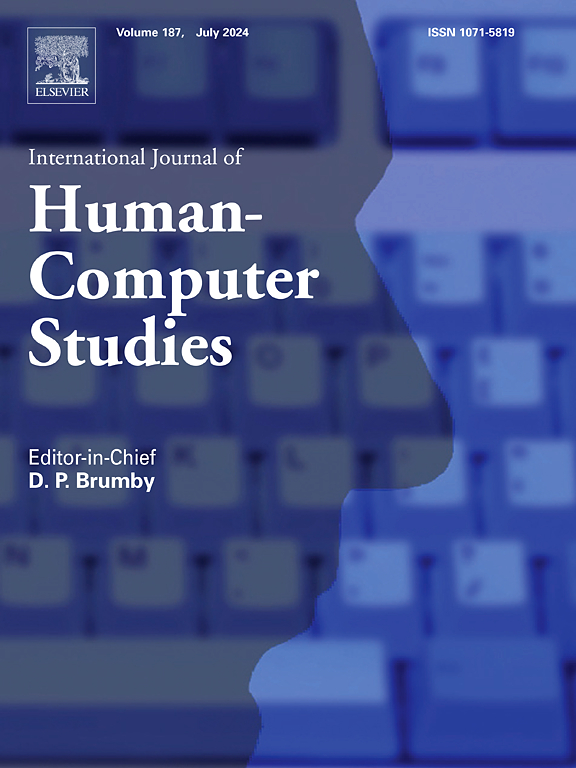ost - hmd的最佳信息位置:偏心和方向对两种AR信息的影响
IF 5.3
2区 计算机科学
Q1 COMPUTER SCIENCE, CYBERNETICS
International Journal of Human-Computer Studies
Pub Date : 2025-05-08
DOI:10.1016/j.ijhcs.2025.103529
引用次数: 0
摘要
光学透明头戴式显示器(ost - hmd)通过在用户的眼睛上叠加AR信息来提高性能。然而,受成像技术的限制,可见性问题(例如位置)会影响用户的体验。以前的研究没有涉及偏心率,而且研究方向有限。本文通过两个实验研究了不同AR信息类型对偏心率和方向的影响。我们比较了视觉表现和主观偏好的偏心率(2.39°,4.77°,7.15°)和方向(上,下,左,右,左上,左下,右上,右下)。实验1发现,与任务相关的AR信息在左上角和左上角识别效果最好,在2.39°处具有最高偏好;实验2发现,与任务相关的AR信息在右下角和右下角识别效果最好,在2.39°和右下角具有最高偏好。最佳位置随任务的不同而不同。综上所述,本研究强调了信息类型对于理解和优化AR信息位置的重要性,揭示了偏心和方向的影响。本文章由计算机程序翻译,如有差异,请以英文原文为准。
Optimal information position in OST-HMDs: The effect of eccentricity and direction across two types of AR information
Optical See-Through Head-Mount Displays (OST-HMDs) improve performance by superimposing AR information on the user's eyes. However, limited by imaging technology, visibility issues (e.g. positions) affect the users’ experience. Previous studies did not involve eccentricity and had a limited direction. This paper investigated the impact of eccentricity and direction across different AR information types in two experiments. We compared visual performance and subjective preference for eccentricities (2.39°, 4.77°, 7.15°) and directions (top, bottom, left, right, top-left, bottom-left, top-right, bottom-right). Experiment1 found Non-Task-Related AR Information was best identified at left and top-left, with the highest preference at 2.39° Experiment2 explored Task-Related AR Information was best identified at bottom and bottom-right with 2.39°, with the highest preference at 2.39° and right. The optimal positions varied with different task. In conclusion, this study emphasized the importance of information types for understanding and optimizing AR information position, and revealed the effect of eccentricity and direction.
求助全文
通过发布文献求助,成功后即可免费获取论文全文。
去求助
来源期刊

International Journal of Human-Computer Studies
工程技术-计算机:控制论
CiteScore
11.50
自引率
5.60%
发文量
108
审稿时长
3 months
期刊介绍:
The International Journal of Human-Computer Studies publishes original research over the whole spectrum of work relevant to the theory and practice of innovative interactive systems. The journal is inherently interdisciplinary, covering research in computing, artificial intelligence, psychology, linguistics, communication, design, engineering, and social organization, which is relevant to the design, analysis, evaluation and application of innovative interactive systems. Papers at the boundaries of these disciplines are especially welcome, as it is our view that interdisciplinary approaches are needed for producing theoretical insights in this complex area and for effective deployment of innovative technologies in concrete user communities.
Research areas relevant to the journal include, but are not limited to:
• Innovative interaction techniques
• Multimodal interaction
• Speech interaction
• Graphic interaction
• Natural language interaction
• Interaction in mobile and embedded systems
• Interface design and evaluation methodologies
• Design and evaluation of innovative interactive systems
• User interface prototyping and management systems
• Ubiquitous computing
• Wearable computers
• Pervasive computing
• Affective computing
• Empirical studies of user behaviour
• Empirical studies of programming and software engineering
• Computer supported cooperative work
• Computer mediated communication
• Virtual reality
• Mixed and augmented Reality
• Intelligent user interfaces
• Presence
...
 求助内容:
求助内容: 应助结果提醒方式:
应助结果提醒方式:


